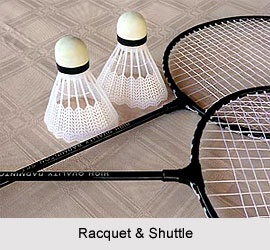 Badminton is extensively played throughout India, although it lacks the recognition of games such as cricket. Indeed, the modern version of the game has its origins in Pune, when British army officers introduced the net and devised the first rules of the game. Tournaments at various levels including the state, regional and national level are held in India and a few Indian practitioners of the sport have attained international acclaim.
Badminton is extensively played throughout India, although it lacks the recognition of games such as cricket. Indeed, the modern version of the game has its origins in Pune, when British army officers introduced the net and devised the first rules of the game. Tournaments at various levels including the state, regional and national level are held in India and a few Indian practitioners of the sport have attained international acclaim.
The following are the badminton rules in a nutshell:
* Service in badminton must be delivered underhand. There are four types of service-short, high, drive and flick.
* The server must stand with both feet within his service court and neither foot should touch the line.
* The receiver may stand anywhere within his service court.
* Some part of the feet must be in contact with the floor at the same spot, until the shuttle is hit.
* Who will serve first is decided by tossing a coin. Only the server can add to his/her score.
* If the receiving side wins a rally, the score remains static but service change takes place.
* In doubles, two partners serve consecutively except that at the starting of the game only one service is allowed. After both lose the service, the service changes to the other team
* A side loses the relay if: a) the shuttle falls outside the boundary; b) the service fault is committed; c) the shuttle is held on the racket.
* Double hit: This is a term commonly used when a shuttle is struck by two distinct touches of the racket. Until 1968, any double hit was a fault. But in 1968, the rule of double hit was changed to invalidate a hit only when a player made two strokes at the shuttle.
* Wood shot: This term is used for miss-hits when the shuttle is totally or partially struck by the frame of the racket. Clean hits off the frame of the racket or the wood shot are valid since 1963.
* A `let` occurs only as a result of any unforeseen or accidental hindrance such as a shuttle from a neighbouring court interfering with play or a shuttle being caught in or held on the net. When a let occurs, the whole rally is replayed.
* If the score reaches 14-all, the player or pair, which first reaches 14 points, has to give the defending player/pair the option of `setting` the game for a further three points. If the game is extended by three points, then the score is called` love-all` and the first side to score three points wins the game, if 14- all, then the game may be completed straight or extension of three points may be allowed.
* The women`s singles game is of 11 points. If a game reaches 9-all, it may be set for three points and at 10-all, for two points.
* In the third game the opponents change ends halfway through it, i.e., when one side`s score reaches eight in a game of 15 and six in a game of 11.




